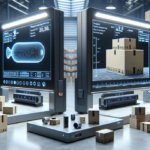Introduction: QubeVu by Postea vs Honeywell AutoCube 8200
In the realm of warehouse management and logistics, the precision and efficiency of dimensional measurements are pivotal. Dimensioning systems like QubeVu by Postea and Honeywell AutoCube 8200 have become leading solutions, providing automated and precise measurements of packages and products. This comprehensive comparison delves into their features, benefits, costs, and customer feedback, offering insights to help businesses make informed decisions.
Understanding the Need for Dimensioning Systems in Logistics
Dimensioning systems are essential in logistics management, offering real-time and accurate measurements of packages and products. According to a McKinsey report, optimizing warehouse operations can lead to a 20-30% increase in efficiency. These systems enable logistics companies to:
- Optimize warehouse space and reduce shipping costs
- Automate measurement processes, saving time and minimizing human error
- Comply with international regulations related to package dimensions and weight
By ensuring packages meet required standards, dimensioning systems help avoid penalties and shipping delays, especially crucial for companies engaging in international shipping.
The Benefits of Using Dimensioning Systems in Warehouse Management
Implementing dimensioning systems offers a multitude of advantages for warehouse management:
- Increased accuracy and precision in measuring package dimensions
- Reduced human error leading to improved operational efficiency
- Better optimization of warehouse space and strategic product placement
- Enhanced safety and reduced risk of package damage
- Real-time data and analytics supporting informed decision-making
Additionally, accurate dimensioning helps in reducing shipping costs by calculating precise dimensions and weight, enabling the selection of the most cost-effective shipping methods. Identifying irregularly shaped packages also allows for special handling, minimizing damage during transit.
Comparative Analysis: QubeVu by Postea vs Honeywell AutoCube 8200
Features and Specifications
QubeVu by Postea and Honeywell AutoCube 8200 utilize distinct technologies for measuring package dimensions:
- QubeVu employs 3D imaging and advanced algorithms to capture precise measurements
- AutoCube 8200 uses laser scanners and cameras to create detailed 3D models
Below is a comprehensive comparison of the key features and specifications of QubeVu by Postea and Honeywell AutoCube 8200:
| Feature | QubeVu by Postea | Honeywell AutoCube 8200 |
|---|---|---|
| Measurement Range | 2 x 2 x 2 cm to 360 x 360 x 360 cm | 2.5 x 2.5 x 2.5 cm to 243.8 x 243.8 x 243.8 cm |
| Weight Capacity | Up to 100 kg | Up to 68 kg |
| Measurement Speed | Less than 3 seconds | 2-3 seconds |
| Accuracy | ± 0.25 cm | ± 0.5 cm |
| Integration | Compatible with popular logistics software | Compatible with Honeywell RT10/RT20 mobile computers |
| Price | Starting from $5,995 | Starting from $9,100 |
One notable difference lies in their design and deployment:
- QubeVu is a standalone device, offering flexibility for use in various warehouse locations
- AutoCube 8200 is designed for integration with conveyor systems, providing consistent and accurate measurements for moving packages
Businesses need to consider their operational setup to determine which system aligns better with their workflow.
Accuracy and Precision
When evaluating accuracy and precision, QubeVu outperforms AutoCube 8200 with an accuracy of ± 0.25 cm compared to ± 0.5 cm. This enhanced precision is critical in applications where measurement accuracy directly impacts operational efficiency and cost calculations.
However, AutoCube 8200 offers a higher weight capacity, measuring packages up to 68 kg, whereas QubeVu handles up to 100 kg. Real-time measurement capabilities of QubeVu facilitate faster processing in high-volume environments, while AutoCube 8200’s user-friendly interface simplifies operations for users with limited technical expertise.
Ultimately, the choice between the two systems hinges on specific operational priorities:
- If accuracy and precision are paramount, QubeVu is preferable
- If weight capacity and ease of use are more critical, AutoCube 8200 stands out
Ease of Installation and Use
Both dimensioning systems prioritize user-friendliness and quick setup:
- QubeVu features a plug-and-play design, enabling setup in under 30 minutes
- AutoCube 8200 offers straightforward setup and calibration but requires Honeywell RT10/RT20 mobile computers for operation
Integration with existing logistics software is seamless for both systems, allowing for efficient incorporation into current workflows.
A key distinction is in their scanning processes:
- QubeVu supports touchless scanning, where users simply place packages on the platform without manual alignment or triggering
- AutoCube 8200 necessitates manual initiation of the scanning process via a button on the mobile computer
The touchless feature of QubeVu enhances convenience and reduces user error, making it a more efficient option in dynamic warehouse settings.
Customer Reviews and Feedback
Both QubeVu and AutoCube 8200 have garnered positive customer feedback:
- QubeVu users commend its accuracy, ease of use, and compatibility with popular logistics software
- AutoCube 8200 is praised for its speed, accuracy, and seamless integration with Honeywell mobile computers
However, some users have reported compatibility issues and occasional software glitches with AutoCube 8200. Conversely, feedback for QubeVu highlights the responsiveness and effectiveness of its customer support team.
Additionally, certain users noted that AutoCube 8200’s heavier design can pose challenges in warehouses requiring frequent mobility. Despite these minor drawbacks, both systems remain favored choices for businesses aiming to enhance their logistics operations.
Cost Analysis
In terms of pricing, QubeVu offers a more budget-friendly option starting at $5,995, whereas AutoCube 8200 begins at $9,100. Total costs can vary based on factors like installation, software licenses, and ongoing maintenance fees.
It's crucial to consider the long-term cost savings each system can provide:
- QubeVu has been shown to reduce shipping costs by up to 20% through accurate dimensioning and minimizing dimensional weight charges
- AutoCube 8200 similarly optimizes warehouse space and reduces shipping expenses
While the initial investment may be higher for AutoCube 8200, the return on investment can be substantial depending on the scale and nature of the logistics operation. Businesses should evaluate both the upfront costs and the potential savings to determine the most economical choice.
Factors to Consider When Choosing the Right Dimensioning System
Selecting the right dimensioning system involves assessing various factors aligned with your logistics goals:
- Budget and Cost-Effectiveness
- Accuracy and Precision Needs
- Weight Capacity Requirements
- Ease of Installation and Software Integration
- Customer Reviews and Feedback
Additionally, consider the size and shape of the items you handle:
- QubeVu excels with irregularly shaped items
- AutoCube 8200 is more efficient for standard, cuboidal items
For operations dealing with a diverse range of item shapes and sizes, QubeVu may offer greater flexibility. Conversely, if your inventory predominantly consists of uniform packages, AutoCube 8200 could provide enhanced efficiency and cost savings.
Future Trends in Dimensioning Systems for Logistics
As technology advances, dimensioning systems in logistics are expected to incorporate more sophisticated features:
- AI-Powered Analytics for predictive insights and enhanced decision-making
- Improved Sensors offering higher accuracy and faster processing times
- Automated Workflows streamlining operations and reducing manual intervention
Moreover, the logistics industry is increasingly prioritizing sustainability. Future dimensioning systems may focus on:
- Using eco-friendly materials in packaging
- Developing efficient transportation routes to minimize fuel consumption and reduce carbon emissions
Integrating sustainable practices not only benefits the environment but also enhances operational efficiency and meets the growing demand for environmentally responsible logistics solutions.
Conclusion: Which System is the Best Fit for Your Business?
Both QubeVu by Postea and Honeywell AutoCube 8200 offer unique features and benefits tailored to different logistics needs. If your operation prioritizes accuracy and precision, QubeVu is the optimal choice. On the other hand, if weight capacity and ease of use are more critical, AutoCube 8200 may better serve your requirements.
Ultimately, the decision should be based on a thorough assessment of your business's specific needs, budget constraints, and feedback from industry peers. Investing in the right dimensioning system will not only streamline your logistics operations but also contribute to cost savings and enhanced customer satisfaction.






















